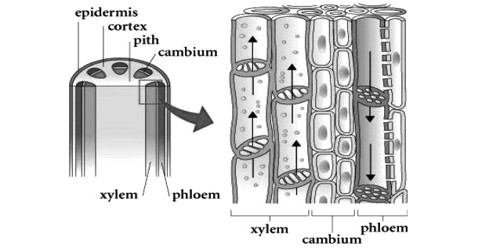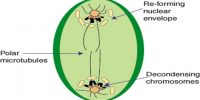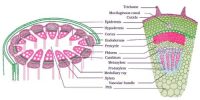Complex tissue is composed of more than one kind of cells. The complex tissues are generally heterogeneous in nature, being composed of dissimilar types of cell elements. They are two types, namely Xylem tissue and Phloem tissue.
Xylem Tissue
Xylem is a multifaceted tissue forming a part of the vascular bundle. It is mainly instrumental for transmission of water and solutes, and also for perfunctory support. This tissue helps to conduct the water and nutrients upwards and also helps them to form the bark. Xylem tissue consists of four types of cells, namely: Tracheids, Vessels or Trachea, Xylem fibre and Xylem Parenchyma.
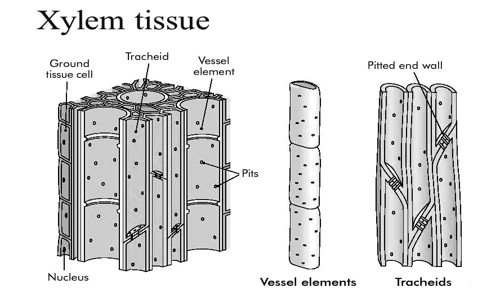
- Tracheids:
A tracheid is a very much elongate cell occurring along the long axis of the organ. Cells are dead, long with transverse ends, containing large vacuole. Cell walls are hard, strong. and lignified. The cells are devoid of protoplast, and hence dead. Cell walls are thickened with lignin. Their main functions are to give mechanical strength and to supply water and dissolved minerals from the root to the leaves.
- Vessels or Trachea:
Cells are broad and short, placed end to end to form a continuous hollow tube. The transverse walls between the cells are almost dissolved forming a continuous channel or water-pipe. Water and water dissolved minerals are conducted from root to leaf by these cells. The cells are dead.
- Xylem fibre:
These are sclerenchymatous cells. Some fibres remain connected with other elements in the complex tissue, xylem, and they mostly give mechanical support. Their main function is to give mechanical strength to the plant.
- Xylem parenchyma:
These are parenchymatous cells. Living parenchyma is an ingredient of the xylem of most plants. In the main xylem, they remain related to other elements and derive their origin from the similar meristem. These are made up of parenchymatous cells. They are thin walled and are living. Functions of these cells are storage and conduction of food materials.
Occurrence: Found in the root, stem and leaves. They occur along with phloem to form the vascular bundle.
Functions of Xylem Tissue
Their functions are to give mechanical strength to the plant body, conduction of water, minerals and food materials and storage of food. Main functions are, Conduct water and minerals upwards from the roots to the stem and leaves.
Phloem Tissue
Phloem tissue consists of four types of cells, namely: sieve tubes, companion cells, phloem fibres and phloem parenchyma. This tissue helps to transport food from leaves to other parts of the plants and they are made up of dissimilar types of cells. The elements of phloem originate from the procambium of apical meristem or the vascular cambium.
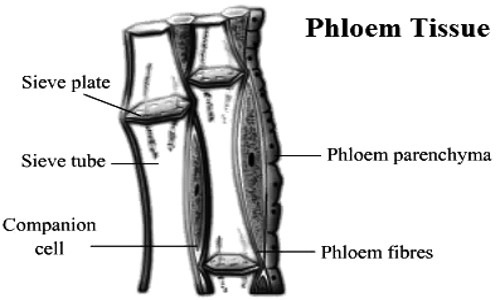
- Sieve tube
These are elongate hollow cells placed end-to-end forming. The most significant constituents of phloem are the sieve elements, the sieve tubes and sieve cells. The partition walls between two adjacent sieve cells are perforated and known as sieve plate. In mature sieve tube, there is no nucleus in the cell. Conduction of food, prepared in the leaves is its main function.
- Companion cells
These are parenchymatous, narrow, elongated cells, and are closely associated with the sieve tube. Companion cells remain related with the sieve tubes of angiosperms, both ontogenetically and physiologically. They have dense cytoplasm and a large nucleus. Conduction with the sieve tube is done through the pores present on the walls of these cells. They help the sieve tubes in the conduction of food materials.
- Phloem fibre
These are Sclerenchymatous cells. Sclerenchymatous fibres constitute a part of phloem in a large number of seed plants. They are also known as bast fibre. Its function is to give mechanical strength.
- Phloem parenchyma
These are parenchymatous cells. Besides companion cells and albuminous cells, a good number of parenchyma cells remain connected with sieve elements. They help in storage and conduction of food materials.
Occurrence: Phloem is found in all parts of the plantlike roots, stem and leaves. They occur jointly with the xylem to form the vascular bundle.
The function of Phloem Tissue
- Their main function is to conduct food materials, prepared in the leaves, to different parts of the plant.
- They give mechanical strength to plant organ.
- In case of necessity, they store food materials from the leaves to the growing parts of the plant and the storage organs.
